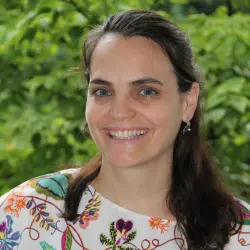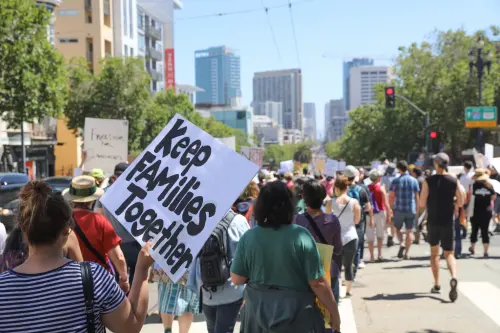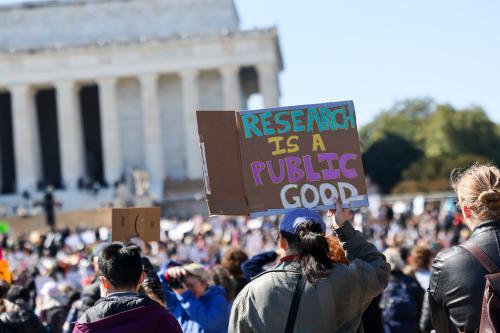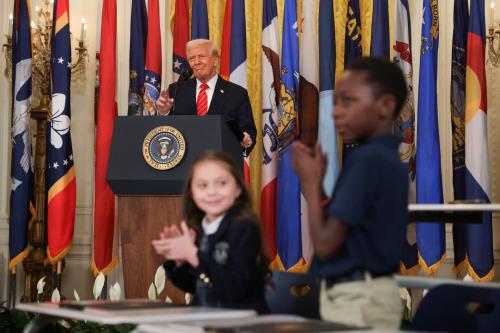With less than 100 days before the United States presidential election, candidates are pushing their campaigns into overdrive. Harris’s and Trump’s campaigns will be working hard to secure the youth vote, a base that played a crucial role in swaying the 2020 election. In the 2024 presidential election, over 8 million young people will be eligible to vote in a presidential election for the very first time, creating a youth voter base 41 million strong. But are candidates listening to the voices of youth voters and what matters most to them?
Written by three students from the University of Nevada, Las Vegas (UNLV), this commentary explores what matters to youth voters on the topic of education. Although the June 2024 presidential debate briefly touched on the issue of student loans, we argue that education issues— particularly student debt, equity and quality of learning, and school safety—need to be front and center in national debates and media coverage.
Youth perspectives from the University of Nevada, Las Vegas
Las Vegas is a racially, socially, and economically diverse metropolitan area that has been a prominent stopover for both campaigns as candidates try to entice voters. In Nevada, a presumed swing state in the 2024 election, almost 30,000 youth voters between the ages of 18 and 24 have registered to cast their ballot for their first presidential election.1 According to one political analysis, “Nevada is younger and more diverse than any other battleground.” As in the rest of the U.S., youth perspectives are critical for policy makers and aspiring leaders to consider as they formulate their political agendas.
In the spring 2024 semester, we surveyed a dozen fellow students in the Brookings Public Policy Minor program at the UNLV who reflect the diversity of Las Vegas—including Latino/a students, those who identify as first-generation students and Americans, and/or are working full-time—to hear what they want to see beyond the education agenda as we move into a new school year and the November elections. UNLV, Nevada’s largest university, ranks among the United States’ top five most-diverse student bodies. Over half of the students at UNLV are the first in their families to earn degrees and many work part- or full-time to afford their education.
A high proportion of UNLV students come from Nevada’s Clark County School District, in a state where public school systems are among the most poorly funded in the country. Over 47% of Clark County students are Hispanic or Latino, and in 2021 75% of students were eligible for free and reduced lunch. Only 51% of high school graduates from Clark County enrolled in a higher education institution in 2018, compared to the national average of 64%. Higher education outcomes are linked to students’ experiences at the K-12 level, and inequities stemming from an under-resourced K-12 schooling persist when students enter college. Resources for the university are critical to support students in successfully transitioning to college, especially those who identify as first generation college students. Like other universities across the country, UNLV faces a $9.6 million budget shortfall for the upcoming 2024-2025 school year despite being located within walking distance of the famous Las Vegas Strip, which generates the highest revenue in the country from gaming.
Prospective and current UNLV students face an on-going struggle to ensure they have the skills and conditions to succeed in their studies. This includes overcoming discrepancies in their K-12 education, navigating a university space new to their families, and working full-time. They are making hard decisions about financing their education, decisions that both inform and are informed by how they see the role of education in their lives and their society.
Realizing the promise of education
While there are a multitude of reasons students pursue an education, the majority of UNLV students emphasized how education prepares them to enter the workforce and to become active, informed, and civically minded community members. As one student noted, “education opens doors to well-paying and stable jobs … and serves as a source of opportunity [and] social mobility.” The first-generation college students who shared their perspectives explained how the economic purpose of education was tied to the American dream: “As a first-generation college student raised by an immigrant, single mother, I am a product of ambition. Originally from Puebla, México, my mother came looking for possibilities for the next generations of her family. … [My] obligations are to be dedicated to our work, focus on education, offer back to the community, and continue to dream.”
UNLV students also described intrinsic benefits of education, such as developing critical thinking skills, and more civic-oriented purposes. “School should not only teach you how to work but teach you how to live … make you a better member of society and your community,” one student insisted. Another student added, “Civic engagement and government, cultural competency, leadership, and social skills should all be learning outcomes from school as well.”
The complex and multi-faceted purpose of education is part of an ongoing dialogue on the purpose of education conducted by the Center for Universal Education at Brookings, where the perspectives of students, educators, and families have been studied across countries and contexts by the Family, School, and Community Engagement in Education initiative.
Keeping student debt at the top of the agenda
One of the top education issues at the national and state levels so far in 2024—and that UNLV students wanted to see remain a priority—is the rising costs of higher education and the student debt crisis. This includes FAFSA process changes, the Biden administration’s student debt relief initiatives, and increases in higher education costs. From 2002 to 2022, the average costs at a four-year college increased 179%, roughly 9% annually.
As a result, an increasing number of young people across the U.S. and at UNLV, are questioning whether the benefits of higher education are worth the cost and want more action from policymakers. As UNLV students reiterated, education is not a slam dunk to a more promising economic future and realizing the American dream of prosperity. “Only 1.9% of students at UNLV came from a poor family but became a rich adult.”
Moving equity and inclusion and school safety to the top of the agenda
In addition to student debt, UNLV students felt that media coverage often focused on school budget and learning deficits and the gloom and doom state of education. One student said, “I see coverage about how schools are underfunded and teachers are underpaid (and therefore working multiple jobs and often quitting education).” Another student added, “When it comes to students missing benchmarks, I think there isn’t enough coverage of possible solutions.”
Yet, UNLV students felt that the equity and inclusion concerns underlying these deficits were not covered in enough detail, nor how deficits in K-12 education contributed to young people struggling to succeed in higher education. One student mentioned, “Our education system [in Nevada] is so bad compared to other states,” attributing this to the inequitable K-12 preparation they felt they received. In the 2022-2023 school year, Black and Indigenous students graduated at rates at least 15% lower than white and Asian students in the State of Nevada. Students were frustrated that rather than focusing on the racial, socioeconomic, and other disparities impacting quality of education and impacting educational outcomes, the media tended to spotlight culture war discussions on book banning, critical race theory, and other issues, which UNLV students viewed as a smoke screen for talking about the underlying inequities in quality of education.
Lastly, a topic of great importance to UNLV and students across the U.S. is school safety. Given UNLV students’ recent tragic experience in December 2023 where a gunman opened fire and killed three faculty, they did not want to see school safety glossed over or quickly forgotten from national and state media. As of July 11, 2024, 35 school shootings have taken place this year, nine of which were on college campuses. Media and political attention tends to increase after a school shooting, but quickly disappears while youth, educators, and their families suffer the consequences long after the media has moved onto another story.
Centering youth perspectives on education
With less than 100 days before the presidential election, candidates need to find ways to make space in their campaigns for youth perspectives so that they can contribute meaningfully to the electoral process and have their voices heard. This means acknowledging youth leadership and engagement as an asset to our democratic processes.
Across the country students are serving as voices of change and unity in their schools and education institutions. For example, after a ban of diversity, equity, and inclusion initiatives at the University of Texas, students organized a Latinx Graduation to celebrate their accomplishments. Middle school students in Virginia worked with education leaders to address disparities in honors classes and exclusionary dress code policies.
Here are three ways in which decision makers and leaders can ensure that youth perspectives are centered in policy and media agendas:
- Create intentional spaces to listen to and center youth perspectives. If candidates and decision makers want to appeal to the youth vote and student voice, they need to center youth voices consistently and intentionally in policymaking efforts and structures. This includes safe and intentional spaces to provide ideas, participate, and connect with policymakers.
- Ensure youth are at the policymaking table. This means not just offering youth a seat at the table, but rather changing the culture of the table to be inclusive of youth. One exemplary effort in Nevada is the Nevada Youth Legislature, where high school students present one piece of legislation that is heard in committee by the legislature, then voted on and sent to the governor if approved.
- Collaborate with youth-led organizations and movements. Directly collaborating with youth-led organizations and movements should be the status quo for decisionmakers and candidates. For example, Michigan’s Department of State partnered with Michigan State University’s campus organizations and athletics program to hold a town hall on early voting and to collectively encourage civic engagement.
The 41 million eligible youth voters deserve the same consideration and respect as other demographic populations in the political process. Centering youth perspectives on what matters to them in education and political agendas needs to move from clicks to progress. Making youth participation a norm in decisionmaking will in turn support greater youth engagement and agency in the democratic process at a moment when youth are feeling increasingly discouraged about the future and are seeking both solutions and hope.
-
Footnotes
- 29,557 Nevadans between the ages of 18-24 were calculated to have registered to vote since the 2020 presidential election. The age group had 210,698 total registered voters in December 2020 and 240,255 registered voters as of June 2024, according to statistics from Nevada’s Secretary of State. https://www.nvsos.gov/sos/elections/voters/voter-registration-statistics
The Brookings Institution is committed to quality, independence, and impact.
We are supported by a diverse array of funders. In line with our values and policies, each Brookings publication represents the sole views of its author(s).




Commentary
Youth voices in the 2024 election
What students want to see on the education agenda
August 26, 2024